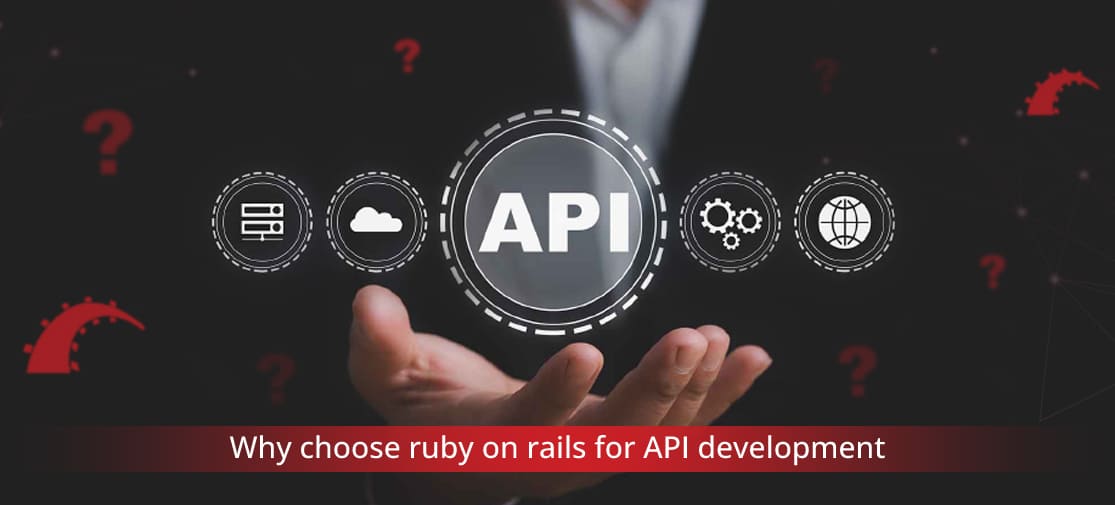Introduction
Ruby on Rails development is a well-known open-source framework that is based on MVC(model-view-controller) and is used for developing online stores with decent and sophisticated browsing and purchasing options.
There is no doubt the simplicity and user-friendly aspects of Ruby on Rails are widely recognised making the best choice to create a robust and efficient Application Programming Interface (API).
As we know API is a software interface that allows communication between more than 2 systems and for that ROR is the most suitable framework for setting up a basic API to advance features. So, let’s dive in deep into how Ruby on Rails is preferred more for API development.
Ruby on Rails for API development?
Before, creating an API with ROR let’s discuss the benefits of API by using Ruby on Rails.
- Connection Over Configuration: It simplifies API development by providing sensible defaults and reducing the excessive need for configuration.
- Modularity: APIs are built as separate modules with your applications for clear code separation and maintenance.
- Active Record: Ruby on Rails has built-in ORM(Object- Relational Mapping) known as active records that simplifies database interactions, and makes it easy to create, read, update, and delete records.
- Scalability: ROR can handle API’s scaling function efficiently as it supports caching, background process, and microservice integration as well.
So, it’s clear that Ruby on Rails is beneficial for creating robust and efficient API development.
Getting Started with ROR for API Development
We are well-known with the benefits of API by using Ruby on Rails development. So, let's look further at how to implement it.
1. Setup
Let’s start with the basic step of setting it up where you need to
- Install Rails: If you are new and haven't installed the ROR framework then follow the instructions on the official website for a complete installation.
- Creating a new Rails Project: To create a new project you need to open your terminal and run the following command in it.
rails new my_api --api - Create a Controller: By generating a controller it handles the API request
rails generate controller api/v1/posts
2. Define Routes
Next over here you have to define the routes for your API in the config/routes.rb file.
# config/routes.rb
namespace 'api' do
namespace 'v1' do
resources :posts
end
end
For a Post resource in the api/v1 namespace, this configures RESTful routes.
3. Create a Model
Here you have to create a model for your post-resource
rails generate model Post title:string content:textTo create the post table you need to run the database migration
rails db: migrate4. Create a Controller
Now you need to create actions to handle API requests in the app/controllers/api/v1/posts_controller.rb request
# app/controllers/api/v1/posts_controller.rb
class Api::V1::PostsController < ApplicationController
before_action :set_post, only: [:show, :update, :destroy]
def index
@posts = Post.all
render json: @posts
end
def show
render json: @post
end
def create
@post = Post.new(post_params)
if @post.save
render json: @post, status: :created
else
render json: @post.errors, status: :unprocessable_entity
end
end
def update
if @post.update(post_params)
render json: @post
else
render json: @post.errors, status: :unprocessable_entity
end
end
def destroy
@post.destroy
end
Private
def set_post
@post = Post.find(params[:id])
end
def post_params
params.require(:post).permit(:title, :content)
end
end
This controller defines CRUD actions for managing Post resources.
5. Start The Server
You can start your Rails server with
Your API will be accessible at http://localhost:3000/api/v1/posts.
Advanced Features of API on ROR
From the year September 2022, Ruby on Rails was released and it’s continuously upgrading with its new version. Every version is beneficial for the developers as well as for API development with its advanced features such as
- Authentication and Authorization: It’s the mechanism of authentication and authorization of the user by using gems like Devise or Oauth2.
- Versioning: Acquire the knowledge of versioning your API to guarantee backward compatibility with current clients.
- Serialization: Tools like Active Model Serializers or JSONAPI::Resources to format API responses in a structured and consistent manner.
- Pagination: Implement pagination to manage large datasets efficiently.
- Testing: To verify robustness, use tools like RSpec or MiniTest to test for your API services.
Conclusion
Ruby on Rails is capable of creating a powerful and scalable API. So, whether you are creating web or mobile applications on ROR coding then Techvoot Solutions has got your back. Our experts have the tools and the knowledge to develop cutting-edge customised software that emperors your application and delights your users.




